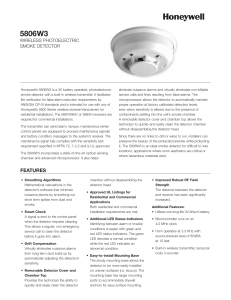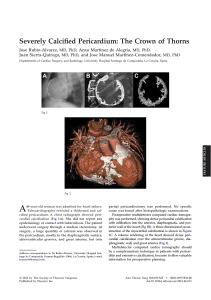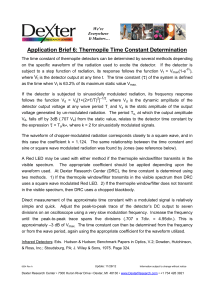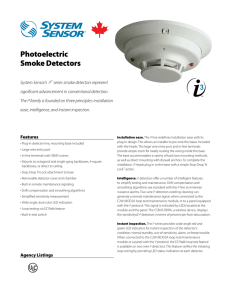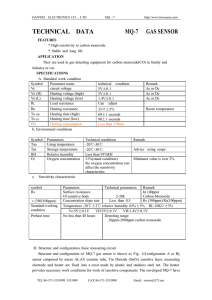Efecto de la composición de la fase móvil sobre el comportamiento cromatográfico y electroquímico de las catecolaminas y metabolitos
Anuncio
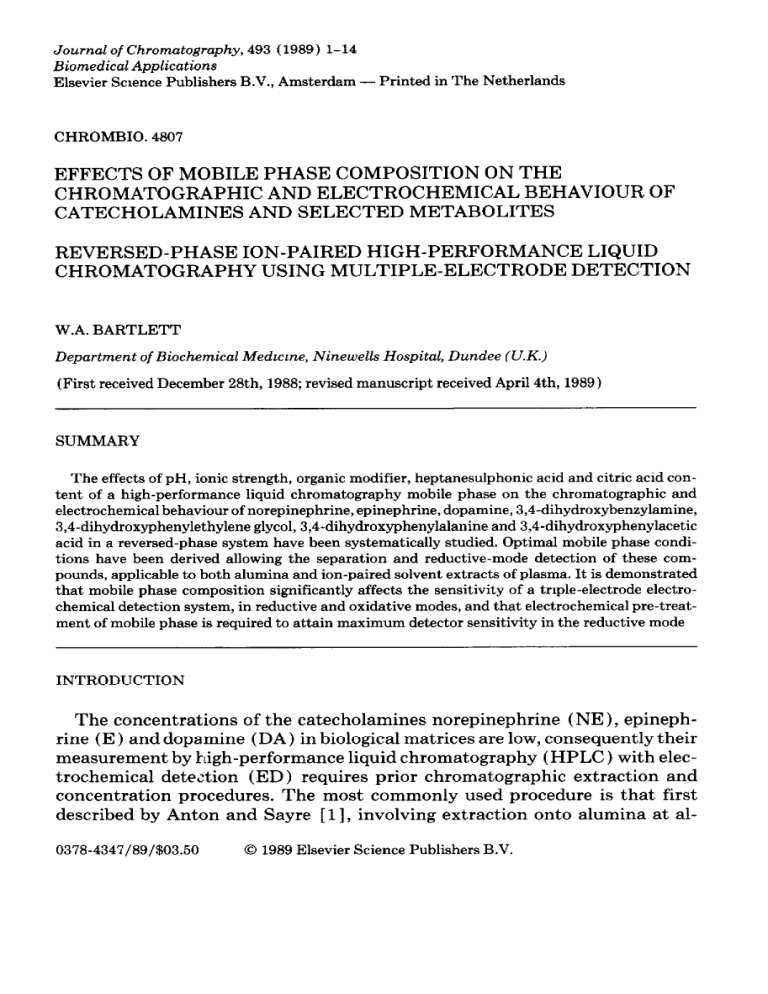
Journal of Chromatography, 493 (1989) 1-14 Biomedical Applications Elsevier Science Publishers B.V., Amsterdam - Printed in The Netherlands CHROMBIO. 4807 EFFECTS OF MOBILE PHASE COMPOSITION ON THE CHROMATOGRAPHIC AND ELECTROCHEMICAL BEHAVIOUR OF CATECHOLAMINES AND SELECTED METABOLITES REVERSED-PHASE ION-PAIRED HIGH-PERFORMANCE LIQUID CHROMATOGRAPHY USING MULTIPLE-ELECTRODE DETECTION W.A. BARTLETT Department of Biochemical Medlcme, Ninewells Hospital, Dundee (U.K.) (First received December 2&h, 1988; revised manuscript received April 4th, 1989) SUMMARY The effects of pH, ionic strength, organic modifier, heptanesulphonic acid and citric acid content of a high-performance liquid chromatography mobile phase on the chromatographic and electrochemical behaviour of norepinephrine, epinephrine, dopamine, 3,4-dihydroxybenzylamine, 3,4_dihydroxyphenylethylene glycol, 3,4-dihydroxyphenylalanine and 3,4-dihydroxyphenylacetic acid in a reversed-phase system have been systematically studied. Optimal mobile phase conditions have been derived allowing the separation and reductive-mode detection of these compounds, applicable to both alumina and ion-paired solvent extracts of plasma. It is demonstrated that mobile phase composition significantly affects the sensitivity of a triple-electrode electrochemical detection system, in reductive and oxidative modes, and that electrochemical pre-treatment of mobile phase is required to attain maximum detector sensitivity in the reductive mode INTRODUCTION The concentrations of the catecholamines norepinephrine (NE ), epinephrine (E ) and dopamine (DA ) in biological matrices are low, consequently their measurement by high-performance liquid chromatography (HPLC) with electrochemical deteztion (ED) requires prior chromatographic extraction and concentration procedures. The most commonly used procedure is that first described by Anton and Sayre [ 11, involving extraction onto alumina at al037%4347/89/$03.50 0 1989 Elsevier Science Publishers B.V. 2 kaline pH. The specificity of the extraction results from the interaction of the cis-diol function of the catechol moiety with alumina. Other methods of extraction have been described with similar specificity; these include affinity methods using solid-phase phenylboronic acid [2-41 and ion-paired solvent extraction of diphenylboronic acid and catechol complexes [@I. Attempts to improve the extraction specificity further by use of alumina in combination with ion exchange [ 73 and affinity methods have been reported [ 81, but such methods are cumbersome and must lead to imprecision in quantitation because of their complexity. The specificity problems associated with assays of plasma catecholamine content arise in part because of the presence of comparatively high concentrations of other catschol compounds such as 3,4-dihydroxyphenylethylene glycol (DOPEG), 3,4_dihydroxyphenylacetic acid (DOPAC ) and 3,4-dihydroxyphenylalanine (DOPA) which are coextracted under conditions optimised for the catecholamines. This is true of alumina and the other cis-diol-specific extraction techniques mentioned earlier ]7,9-111. The ideal assay of plasma catecholamine content should therefore incorporate a single simple extraction step, so as to minimise imprecision, in combination with good-quality chromatographic and detection systems to confer required specificity. A comprehensive and detailed study of the chromatographic behaviour of DOPA, DUPEG, DOPAC, NE, E, dihydroxybenzylamine (DHBA) and DA within an ionpaired reversed-phase chromatographic separation system has therefore been undertaken. Using multiple;electrode ED the effects of mobile phase composition upon the electrochemical behaviour of the catecholamines in both oxidative and reductive modes have been investigated; an optimised set of conditions allowing separation of the catecholamines from potential interference is presented and the application of the mobile phase to extracts of plasma demonstrated. The data emphasise the complexity and difficulties associated with method development of this type and illustrate that optimisation of mobile phase is required not only to obtain optimal separation of the compounds of interest, but also to facilitate optimal detector responses. EXPERIMENTAL Materials Citric acid (Sepramar) and Analar-grade potassium salts were obtained from BDH (Poole, U.K.), 1-heptanesulphonic acid, sodium salt monohydrate from Aldrich (Gillingham, U.K.) and methanol (Proanalysis AR) from May and Baker (Dagenham, U.K.). Column packing materials and columns were obtained from Shandon Southern Products (Runcorn, U.K.). All other chemicals and reagents were purchased from Sigma (Poole, U.K. ) . 3 Equipment The HPLC system consisted of a Varian 5020B liquid chromatograph with data acquisition and handling carried out with a Varian 4270 integrator (Varian Assoc., ‘Warring-ton, U.K. Jo.The system was equipped with I Blleodyne 7125 loop injection valve, and either a 2O- or a 50-~1 interchangeable loop was used. A mobile phase flow-rate of 1.5 ml/min was used in all experiments. The stainless-steel column (250 mm x 4.5 mm) was packed according to manufacturer’s instructions with 5-pm Hypersil-ODS using a Shandon slurry packer (Shandon Southern Products). The detection system was an ESA Coulochem 5100A with a 5021 conditioning cell (G) and 5011 analytical cell containing a high-surface-area coulometric electrode (Dl) and a high-sensitivity amperometric electrode (D2) purchased from Severn Analytical (Gloucester, U.K. ). The electrode configuration allows either oxidative- or reductive-mode detection. The conditioning cell provides a single high-surface-area porous graphite workings eh&rrrde which can be set at a positive or negative potential relative to an integral-modified palladium reference system enabling highly efficient oxidation, or reduction, of the chromatographically separated components%.Ilrlthe reductive m_ode:~ t-he oxidised material generated at G would pass on to the serial coupled analytical cell, where partial reduction at low negative potentials may be performed at Dl to screen out potentially interfering compounds in the mobile phase stream bei%re presentation to the amperametric &&rode D2: This process can effectively increase detector specificity as substances which reduce at the lower applied potential will not further reduce at the downstream electrode which can be maintained at higher potentials to allow detection of the compounds of primary interest. Aiternativeiy D-i may be Heidiat a positive potential to further increase the oxidative efficiency of the system providing more substrate for the reductive reaction downstream at D2. The advantages of serial multiple amperometric electrode detection systems have been discussed by Mayer and Shoup [ 121 in terms of improved detector specificity for catechols in reductive mode. The further advantages of the system described in this study are those confered by combination of high-&I= ciency cot&metric- &&odes to generate oxidised~or reduced materials for the downstream reaction, the ability to apply screening potentials and the robust nature of the electrode system allowing easy practical application of reductivemode detection. In the following experiments oxidative detection was performed with G and D2 switched to standby, Dl set at varying positive potential, the output from D1 measured at a gain of 1500. Reductive-mode detection was carried out with G set at + 0.35 V, D1 set at + 0.05 V and D2 at varying negative potentials, the output from D2 being measured at a gain of 2500. The integration system recorded peak height at an attenuation of 512 mV. 4 Mobile phase preparation Aqueous solutions of citric acid, potassium dihydrogen orthophosphate, disodium EDTA and heptanesulphonic acid were made up in distilled water and degassed under vacuum. The pH was adiusted by titration with 1 M potassium hydroxide and the buffered solution was filtered through a 0.2 pm pore size filter. Degassed and filtered methanol was then added and the final volume adjusted with similarly treated distilled water. Standard solutions Stock standard solutions (ranging from 0.5 to 1.2 mA4) were made up in 0.05 M perchloric acid containing sodium metabisulphite, at a concentration of 5 m.M Final dilutions of standards were made in the mobile phase under investigation prior to each experiment. The final concentrations of the solutions of DOPEG, DOPA, NE, DOPAC, E, DHBA and DA used in all experiments were 125.0, 167.3, 113.8, 121.74, 102.6, 136.4 and 225.4 nmol/l, respectively (approximately 2.4 pmol of each on column per 20-,~l injection and 4.5 pmol for DA). Plasma extraction Plasma extraction was carried out using either alumina or the ion-paired solvent extraction method of Smedes et al. [5 1. The alumina method used was a modification of that described by Bouloux et al. [13]. Aliquots (2 ml) of plasma were extracted after addition of 100 ,~l of 2.8 mmol/l aqueous ascorbic acid solution [ 14 I_The WA4 alumina was washed twice with 8 ml of distilled water and desorption of catecholamine was achieved by addition of 1 ml of 0.2 M acetic acid. The catecholamine eluent from each extraction method was freeze-dried and the lyophilised residue resuspended in 50 ~1 of ‘electrochemicaiiy scrubbed’ mobile phase prior to injection of 48 pi of the solution into the HPLC system, RESULTS Effects of mobile phase composition on catechol capacity factors (k’) As shown in Fig: iA, changes in citric acid concentration significantiy affected the k’ values of the catecholamines. At concentrations of 4 and 60 mM there was incomplete separation of DOPAC and NE, and DOPAC and E, respectively Optimum separation of all compounds was achieved at a i5 m&f citric acid concentration as will be described later. Increasing concentration of the ion-pairing agent heptanesulphonic acid (Fig. 1B) predictably increased the capacity factors of the catecholami_nes withlittle effect upon the 12’values of DOPEG, DOPA and DOPAC. At a concentration of 14.3 mM, NE and DOPAC fail to separate, an injected mixture of these two compounds being viewed as a single peak by both visual inspection and the integrator. 5 NE DOPAC I 0 20 40 [CA] Cttr~c Actd (m&7) HSA -6 m/w M -lOSv/v 60 0 z+qqzG 8 [HSA] 16 Hsptanewlfonic CA M 24 5 Acid fmMI =‘EQmM - lO%V/V 10 15 20 [MI Methanol (% v/v1 CA HSA - 16QmM - 6 mlbl Fig. 1. Effect of varying concentrations of (A) citric acid (CA), (B) heptiesulphonic acid (HSA) and (C ) methanol (M ) on the capacity factors (k’ ) of catechol compounds in a mobile phase of potassium dihydrogen orthophosphate (34.8 m&f) and disodium EDTA (0.27 miI4) at pH 3.6. Methanol reduced the k’ values of all components of the standard mixture (Fig. 1C) without affecting the order of elution. Acetonitrile can also be used as an organic modifier, equivalent volumes (%, v/v) reducing k’ values by a factor of 3 to 4 without change of elution order. An increase in the pH (Fig. 2) of the mobile phase leads to a decrease in k’ value for all compounds with the exception of DOPEG. The maximum effect is on those of DOPA and DOPAC, which fail to be retained by the column at pH 5.6. This behaviour was initially thought to provide a possible strategy for removal of these compounds from the chromatogram to enhance specificity of the catecholamine assays, but detector sensitivity to adrenaline decreased significantly at this pH, despite reduced retention times. Increasing phosphate buffer concentrations at three different hydrogen concentrations (Fig. 2) resulted in reduced k’ values for the catecholamines with little effect upon those of DOPA and DOPAC. The data show that many combinations of pH and molar concentrations of potassium dihydrogen orthophosphate are possible which will result in coelution of differing combinations of the components of the standard mixture. Effects of mobile ph-ase composition catecholamines upon electrochemical behaviour of the Oxidative hydrodynamic voltammograms for NE, E and DA were constructed using mobile phases at four different hydrogen ion concentrations (Fig. 3). In the oxidative mode plateau responses were closely approached or 6 A[KH,PO,] : 34 8 mM 16 - +--+ DA m o----B DHBA DOPAC NE u DOPA DOPEG Fig. 2. Effect of increasing mobile phase pH and molarity of potassium dihydrogen orthophosphate (KH,PO,) upon the k’ values of catechol compounds. The mobile phases contained heptanesulphonic acid (10 mM), citric acid ( 18.77 mkf), disodium EDTA (0.27 mM) and KH,PO, at the concentrations shown in each panel. obtained 0.30 V applied potential difference. magnitude were seen at pH Increased times (Fig, peak height response be expected such as mobile phase composition, affects the oxidative process or internal resistance drop (Fig. 3A, B and C) reveal an apparent increase in detector sensitivity as potassium dihydrogen orthophosconcentration shown in 3A, where seen that, 5.6, a response which eventually falls away This pattern constructed under the mobile phase conditions. Increasing the phosphate concentration (Fig. 3B and C ) not enable plateau lower applied potential differences. 5.60 leads loss of the reductive-mode detector response lower applied voltages (Fig. 3D, E and F). By paring oxidative with reductive voltammograms (Fig. it is apparent that much lower applied potentials than in the reductive mode. Increasing mobile phase pH would mode there true decrease this which order of increasing magnitude of responses relative to pH (i.e. 7 700 600 NOREPINEPHRINE 4 A B 500 4w 300 200 100 04 EPINEPHRINE DOPAMINE I / / APDbduJ bWFfJ.1 -0.1 -0.2 +a.1 to.2 -0.3 -0.4 +a.3 tQ.4 348mM I I I -0.1 -0.2 1 -0.3 -0.4 174 2 m&f I -0.1 I I 1 -0.2 -0.3 -0.4 348 0 mM hydrodynamic voltarnmograms of catecholamines Fig. 3. Oxidative (---) and reductive ( ---) under varying mobile phase conditions, The mobile phase consisted of Potassium dihydrogen orthophosphah ( KH,P04), citric acid (15 mM) and heptanesulphonic acid ( 10 d) at PH 3.0 (a), 3.6 (a), 4.6 (x ) and 5.6 (H) with methanol (1055, v/v) as organic modifier. All other conditions as described in the text. APD = Applied potential difference. Fig. 4. Gptimised chromatographic separation of a standard mixture containing DOPEG (1)) DOPA (Z), NE (3), DOPAC (4), E (5), DHBA (6) and DA (7). Mobile phase consisted of KH,POI (34.85 n-&f), pH 3.60, citric acid d), heptanesulphonic acid (8.0 miW), disodium EDTA (0.2 ti) and methanol (lo%, v/v) delivered at a flow-rate of 1.5 ml/min. A 250 mm ~4.5 mm I.D. 5-pm Hypersil ODS column was used and detector voltages were +0.35 V, + 0.05 V and -0.30 V. All other conditions are described in the text. Retention times in minutes append the peaks. pH 5.60, 4.66, 3.00 and 3.66). An optimum pH value must be arrived at to balance these two opposing factors to achieve maximum working sensitivity. Closest convergence in terms of detector sensitivity between oxidative and reductive modes occurs at pH 3.60. Voltammograms are also shown for DA (Fig. 3G, H and I) which has the longest retention; this is reflected in very large increases in apparent detector sensitivity associated with decreased retention which may be masking any other effects, Plateau response values are again achieved more rapidly in the oxidative mode (Fig. 3G ) . The chromatogram shown in Fig. 4 was obtained using mobile phase conditions giving rise to the maximum working reductive-mode detector sensitivity while enabling baseline resolution of the seven compounds contained in the standard mixture. Effect of mobile phase recycling upon detector sensitivity In the course of experiments designed to examine the performance characteristics of plasma catecholamine assays, it was noted that a significant fall in reductive-mode detector sensitivity occurred when using a new batch of mobile phase. Washing the electrodes with 6 M nitric acid and dimethyl sulphoxide did not alleviate the problem nor did the use of distilled water from other sources 9 for mobile phase production. Continuous recycling of the mobile phase (volume 500 ml) at a flow-rate of 1.5 ml/min with electrode potentials G, Dl and D2 set at + 0.35 V, + 0.05 V and - 0.30 V, respectively, led to a gradual and complete return of detector sensitivity (Fig. 5A). Chromatography of the same IIIIJ*I.I-11 0 6 17 18 24 Elution 30 1.1.1.1.1.~ 6 0 Volume 12 18 24 30 frnlj Fig. 5. Effects of mobile phase recycling upon reductive-mode detector sensitivity. Conditions and explanation are described in the text. Peaks: 1= DOPEG; 2 = DOPA; 3 = NE; 4 = DOPAC; 5 = E; 6 =DHBA; 7 = DA. 10 sample using a non-recycled mobile phase produced the chromatogram shown in Fig, 5Bm in whicmhmarked attenuation of the peak heights of ah components of the standard mixture was noted. This effect did not result from poisoning of the electrode system since replacing this mobile phase with the recycled mobile phase used to generate Fig. IA produced the chromatogram shown in Fig. 5C after only 1 h of equilibration of the system. These data suggest that some component of the fresh mobile phase effectively blocks the detector responses, or destroys the catechois on the coiumn, and that this component can be destroyed electrochemically during mobile phase recycling. To test this hypothesis, new mobile phase was pumped through the system and collected at a flow-rate of 1.5 ml/min with the post-column electrodes G, Dl and D2 set at applied voltages of - 0.65 V, - 0.65 V and - 0.30 V, respectively. This provided maximum electrode surface area at negative potential to electrochemically ‘scrub’ the mobile phase. The scrubbed mobile phase was then used to generate the chromatogram shown in Fig. 5D. This process produced an intermediate level of recovery of detector sensitivity as shown by comparison of Fig. 5D with Fig. 5B and C. Increasing the applied potential at G to - 0.77 V increased the background current of the mobile phase from 40 to 80 nA suggesting that more efficient scrubbing may be achieved at higher applied voltage. A volume of 500 ml of new mobile phase was recycled through the system with G and Dl set at -0.77 V and D2 set at -0.30 V at a flow-rate of 1.5 ml/ min for 17 h. Detector settings were returned to operating levels of +0.35 V, +0.05 V and -0.30 V, respectively, for electrodes G, Dl and D2. The chromatogram of the standard mixture shown in Fig. 5E indicates a complete recovery of detector sensitivity. These data confirm the existence of a component within fresh mobile phase which adversely affects detector responsiveness to catechol compounds. The effect is variable in magnitude upon the components of the standard mixture, DOPAC being the least affected, and would appear to be completely negated by application of the electrochemical scrubbing process described above. It should be noted that the scrubbing process did not give rise to changes in the retention times of any of the compounds chromatographed, therefore it is unlikely to be modifying the concentration of citric acid, heptanesulphonic acid, potassium dihydrogen orthophosphate or methanol in the mobile phase. Chromatography of plasma extracts Chromatograms of alumina and ion-paired solvent extracts of a plasma specimen are shown in Fig. 6. The sample represented a pooled plasma obtained by venesection of two normal ambulant subjects. The mobile phase consisted of potassium dihydrogen orthophosphate (34.85 mM), citric acid (15 mM), disodium EDTA (0.4 mM), 1-heptanesulphonic acid (8 mM) and methanol (lo%, v/v). The mobile phase (500 ml) was recycled at a flow-rate of 1.5 ml/min for 18 h with detector electrodes G, Dl and D2 set at applied potentials 11 ALUMINA EXTRACT ION-PAIRED SDLYENT EXTRACT Fig. 6. Chromatograms of alumina and ion-paired solvent extracts of plasma. For conditions see text. Peaks: 1= DOPA, 2 = NE; 3 = DOPAC; 4 = E; 5 = DHBA. of -0.77 V, -0.77 V and - 0.30 V, respectively, Detection voltages used to generate the chromatogram were + 0.35 V, +0.05 V and -0.30 V for G, Dl and D2, the output from D2 being recorded with a 10-s time constant at a gain of 3500 and an integrator attenuation of 1024 mV. The unidentified peak in the chromatogram of the alumina extract (Fig. 6) appears commonly in non-fasted individuals and may represent dihydrocaffeic acid. DISCUSSION The aims of this study were to characterise an HPLC mobile phase and to determine a set of conditions enabling separation of catecholamines free from potential sources of interference in alumina extracts of plasma while maintaining maximum electrochemical detector sensitivity. The final conditions used are a compromise producing the chromatograms shown in Figs. 4 and 6 which represent the best achievable chromatographic separation of NE and E from DOPEG, DOPA and DOPAC producing minimum loss of reductive-mode detection sensitivity for E. The reductive mode of detection was adopted because of theoretical improvement in detector specificity, and practically be- 12 cause of improved baseline stability and cleaner solvent fronts (unpublished observations). The mechanisms of the separation of catecholamines in ion-paired reversedphase systems have been discussed in detail by a number of authors [S-19]. The mobile phase used in this study is similar to that described by Krstulovic et al. [ 151. They used sodium octyl sulphate as the primary ion-pairing agent instead of heptanesulphonic acid used here. They explained the mechanism in terms of mixed ion exchange. The citric acid peak which complicated their chromatograms (obtained at lower pH) was not observed using the mobile phase investigated here; the reasons for this are unclear. The mechanisms controlling the k’ values of DOPAC and DOPA are not affected by citric acid, heptanesulphonic acid or buffer ionic strength (potassium dihydrogen orthophosphate concentration). The effects of pH can be explained in terms of suppressed ionisation at higher hydrogen ion concentrations leading to a greater degree of hydrophobicity with consequent increase in retention. Addition of increasing concentration of methanol to the mobile phase reduce its polarity and predictably reduce the k’ values of the catechols. The prediction of this type of behaviour is useful for optimisation of separation conditions when using complex ion pair-containing mobile phases. The retention times of the catecholamines are influenced significantly by all the variables studied. Therefore, if the separation of the catecholamines is optimised, the variable which least affects their mobility (pH) can be used to modify the position of the other peaks in the chromatogram so as to minimise possible interferences. This type of approach is simple, but necessarily time-consuming and requires meticulous documentation of data following a considerable amount of experimental work. Optimisation of mobile phase conditions using factorial designs and a computer program to predict chromatograms has been proposed by Wester et al. [ZO] to overcome these practical difficulties. However, these authors were primarily interested in the ability to predict separation of monoamine neurotransmitters, precursors and metabolites, and did not take into account the constraints of mobile phase composition upon ED sensitivity. It would, therefore, seem necessary to investigate such effects experimentally so that, for example, the constraints of mobile phase pH on detection limits could be accounted for in their algorithms. The data presented illustrate well the problems of optimising a mobile phase to attain good separation of the compounds of interest while at the same time ensuring minimum loss of detector sensitivity. At pH 5.6, the retention of DOPA and DOPAC is reduced to the extent of elution with the void volume of the column, but at this pH the reductive-mode detector responses to E are reduced considerably. It has been demonstrated [ 211 that in an HPLC system using oxidative-mode amperometric detection of catecholamines, following reversed-phase chromatography on an octadecyl silica column without ion pairing, increasing mobile phase pH over a range of 2-7 results in an increase in 13 their retention times with a concomitant increase in detector sensitivity. Maximum oxidative detector responses were observed between pH 4.5 and 6.5 for NE, pH 5.8 and 6.2 for E and pH 5.0 and 6.5 for DA. A logical conclusion would be that the higher pH values favouring oxidation are less than favourable for reduction. If the reductive-mode detection is to be used, then it is necessary, if the assumption is correct, to choose a compromise pH value for the mobile phase, which favours reduction while enabling production of sufficient oxidised product at the first two electrodes to act as reactant at the downstream reductive electrode. The optimal mobile phase pH in this study was determined by construction of oxidative and reductive cyclic voltammograms under varying conditions and selecting the pH value resulting in closest convergence of the two voltammograms while enabling the required separation. The conditions which give the best achievable separation with maximal sensitivity can thus be derived. The effects of mobile phase recycling on detector sensitivity, as demonstrated in this study, are significant. The identity of the mobile phase component giving rise to the phenomenon is as yet unclear and it is difficult to isolate because the separation and detector sensitivity are interdependent upon all components of the mobile phase. The effect is completely negated by use of the electrochemical scrubbing procedure described, the scrubbed mobile phase remaining useable for up to three weeks. The system equilibrates rapidly with treated mobile phase when dedicated columns are used and consequently does not place intolerable demands on machine time. The data presented here represent a comprehensive study of a mobile phase which highlights the complexities of optimisation of reversed-phase ion-paired chromatographic systems in which the detection system is mobile phase-sensitive. Such a method development is extremely time-consuming and it is therefor essential that complex chromatographic systems of this type be well documented in the early stages of the process. If the method is intended for routine clinical laboratory use, then the information enables fast and more efficient troubleshooting. Moreover, if the method is to be adopted by other users, then the time involved in the introduction of the method can be reduced by preventing unnecessary duplication of effort. The optimised mobile phase has successfully been applied to alumina and ion-paired solvent extracts of plasma and should be readily applicable to urine extracts, where the endogenous levels of catecholamines exact less demanding requirement for detector sensitivity. REFERENCES 1 2 A.H. Anton and D F. Sayre, J. Pharmacol. Exp Ther., 138 (1962) 360. K. Oka, M. Sekiya, H. O&a, K. Fujita, T. Kato and T. Nagatsu, Clin. Chem., 28 (1982) 646 14 3 4 5 6 7 8 9 10 11 12 13 14 15 16 17 18 19 20 21 A.J. Speek, J. Odink, J. Schrijvar and W.H.P. Schreurs, Clin. Chim. Acta, 128 (1983) 103. K. Maruta, K. Fujita and S. Ito, Clin. Chem., 30 (1984) 1271. F. Smedes, J.C. Kraak and H Poppe, J. Chromatogr., 231 (1982) 25. D.M. Simms, Ann. Clin. Biochem., 25 (Suppl.) (1988) 12% C.R. Benedict, J. Chromatogr., 385 (1987) 369. K. Nyyssonen and T. Markku, Clin. Chem ,33 (1987) 1938. D.S. Goldstein, R. Stull, R. Zimlichman, P.D. Levinson, H. Smith and H.R. Keiser, Clin. Chem., 30 (1984) 815. G. Eisenhofer, D.S. Goldstein, R. Stull, H.R. Keiser, T. Sunderland, D.L. Murphy and I.J. Kopin, Clin. Chem., 32 (1986) 2030. A.H. Anton and D.F. Sayre, J. Pharmacol. Exp. Ther., 145 (1964) 326. G.S. Mayer and R.E. Shoup, J. Chromatogr., 255 (1983) 533. P. Bouloux, D. Perret and G.M. Besser, Ann. Clin. Biochem., 22 (1985) 194. D. Hugh, A. Grenan, M.A. Abugila and C. Weinkove, Clin. Chem., 33 (1987) 569. A.M. Krstulovic, W. Dziedzic, L. Bertani-Dziedzic and D.E. DiRico, J. Chromatogr., 217 (1981) 523. A.M. Krstulovic, J. Chromatogr., 229 (1982) 1. I. MoInar and C. Horvath, J. Chromatogr., 145 (1978) 371. I. Molnar and C. Horvath, Clin. Chem., 22 (1976) 1497. W.A. Bartlett, J. Liq. Chromatogr., 8 (1985) 719. P. Wester, J. Gottfries, K. Johansson, F. Klinteback and B. Winblad, J. Chromatogr., 415 (1987) 261. T.P. Moyer and N. Jiang, J. Chromatogr., 153 (1978) 365.
